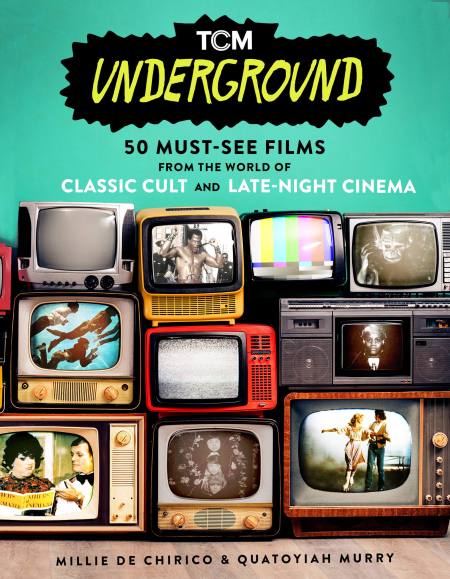GIFT GUIDE: Cult film fanatics rejoice, ‘TCM Underground: 50 Must-See Films’ is now available
Image courtesy of Running Press / Provided by official site.
For a celebration of underground cinema, look no further than the new book by Millie De Chirico and Quatoyiah Murry. TCM Underground: 50 Must-See Films From the World of Classic Cult and Late-Night Cinema is a must-have book for cinephiles and those who like the wonderfully odd factor turned up to 11.
As the book’s title suggests, this is a tome dedicated to TCM Underground, the successful late-night series that plays bizarrely fascinating and cleverly subversive films, mostly from the 1960s, 1970s and 1980s, on the TCM network. De Chirico, chief programmer for TCM Underground, and Murry, film critic and writer, curate an interesting, holistic and surprising list of underground cinema delights that fit into different categories: “It’s Crime Time,” “Domestic Disturbances,” “Fright Club,” “Rebellion & Youth Movements” and “Visual Delights and Other Strange Mind Melters.”
Along the way, the authors give long overdue credence to many forgotten gems, championing risk-taking filmmakers and celebrating representation, agency, inclusion and true “cult” status. There are some entries that are “so bad they’re good,” but most of these 50 films are actually quality cinema that earn that distinction based on their own merits. However, due to a host of issues (mostly being ahead of their time), they were lost celluloid dreams, often derided by critics and sidestepped by audiences during their initial releases. Only in recent years, thanks to repertory runs in theaters and TCM Underground itself, some of the dust has been pushed aside, and these movies have received their proper acclaim and subsequent audience adulation.
In the book, De Chirico and Murry include films that many readers will never have seen or heard of before, which is most welcome. In many ways, this paperback is meant to be an actual cinematic guide for underground-ers to create a playlist and hunt down these rarities on streaming platforms. However, there are a few that should be known to the casually committed cinema celebrant.
The authors begin each film entry with a title card, featuring the country of origin, year of release, color format, running time, director, writer and cast. Accompanying each entry are also photo stills from the film and a commentary essay that summarizes the plot, offers some reasoning on why the movie is included on the list, and historical context on the time period when the film was released. For example, when describing Perry Henzell and Trevor D. Rhone’s script for The Harder They Come, the authors write, “[Henzell’s] script with Rhone is filled with brilliant moments of social critique for the corrupt systems and apathetic institutions that all push Ivan [Jimmy Cliff] to a life of crime. The filmmakers seem to have empathy for the real-life criminal, presenting Ivan as a man willing to work hard if given the opportunity, but the hypocrisy of local religion, the wealth disparity of the island, and the bureaucracy in place left behind by colonial rule make this an improbability.”
Other well-known entries include “The Honeymoon Killers,” the startling crime spree movie written and directed by Leonard Kastle; John Waters’ Polyester, starring Divine and Tab Hunter; Blacula, directed by William Craine and starring William Marshall as the title character; and Two-Lane Blacktop, Monte Hellman’s film starring James Taylor and Dennis Wilson. Kudos to De Chirico and Murry for not going with the obvious. For example, an “underground cinema” book could have easily chosen Waters’ Pink Flamingoes, but doesn’t it feel like that movie has been analyzed enough? Instead, they chose Polyester for a deep dive, which is equally as important as Waters’ earlier film, but sometimes disregarded by cinephiles.
Outside of these 10 or so films that are standards in the cult canon, the rest of the list are obscure oddities that are so engaging to read about and will instantly send people to the internet to figure out where they reside today. Edward Dein’s Shake Out on 101 is one of these films, a movie that follows George (Keenan Wynn), the “owner of a small choke and puke located along Highway 101 on the California coast.” The authors describe the film as having a “shock premise,” being a “tense crime drama” and coming off as a “play being acted out by a cadre of amazing character actors whose camaraderie and rhythm have charmed you so much, you’d likely watch them do anything … and then actually do.”
Another excellent entry: “Friday Foster,” directed by Arthur Marks, and written by Marks and Orville H. Hampton. The film is an impressive bullet point on the long résumé of genre star Pam Grier. Also in the cast are Yaphet Kotto, Carl Weathers, Godfrey Cambridge, Thalmus Rasulala and Eartha Kitt. The movie follows Grier’s Friday character as she is sent to photograph the “Black Howard Hughes,” but what she witnesses instead is an assassination attempt, which catapults the plot into a convoluted conspiracy game. Grier, known for Foxy Brown and Coffy, among other movies, plays a “simple career girl, vulnerable and scared, but brave in the face of danger as she avenges a friend’s death.”
Then, there’s “The Baby,” which feels like a film that needs to be seen ASAP. Ted Post’s movie is billed as a “truly bizarre exploitation film” about a grown man living the life of a toddler, with a “true OMG ending that none of the previous minutes of the film would have predicted.” These “OMG Moments” are a common sidebar throughout the 200-plus pages of the book, offering readers a chance to focus on one scene or character that deserves extra scrutiny. Other sidebars include “A Spotlight on…,” “WTF Moment” and “Cult Connections.”
There’s a lot of necessary ink on films that are social commentaries of their time (and continue to offer lessons in 2022). The authors present the work of many Black filmmakers, but also ensure that the readers understand the nuance of Blaxploitation cinema and that not every film from the time period should be classified as such. There are also some entries from Japanese filmmakers, including Toshio Matsumoto’s Funeral Parade of Roses, which closes out the book. Italy is represented with the horror classic The House by the Cemetery by the legendary Lucio Fulci. Documentaries are included, including The Decline of Western Civilization I, II and III, plus animation with Belladonna of Sadness.
Also, there’s Xanadu. Enough said.
TCM Underground: 50 Must-See Films From the World of Classic Cult and Late-Night Cinema is a perfect entry for anyone’s gift guide this holiday season. It is a perfect compendium for the cinema lover in the household. This dissection and celebration of outside-the-mainstream flicks is an un-Hollywood bible that centers directors, writers, actors and narratives too often relegated to the fringe. Within these pages, the underground is the norm.
By John Soltes / Publisher / John@HollywoodSoapbox.com
TCM Underground: 50 Must-See Films From the World of Classic Cult and Late-Night Cinema. By Millie De Chirico and Quatoyiah Murry. Foreword by Patton Oswalt. Running Press. 240 pages. Click here for more information.


